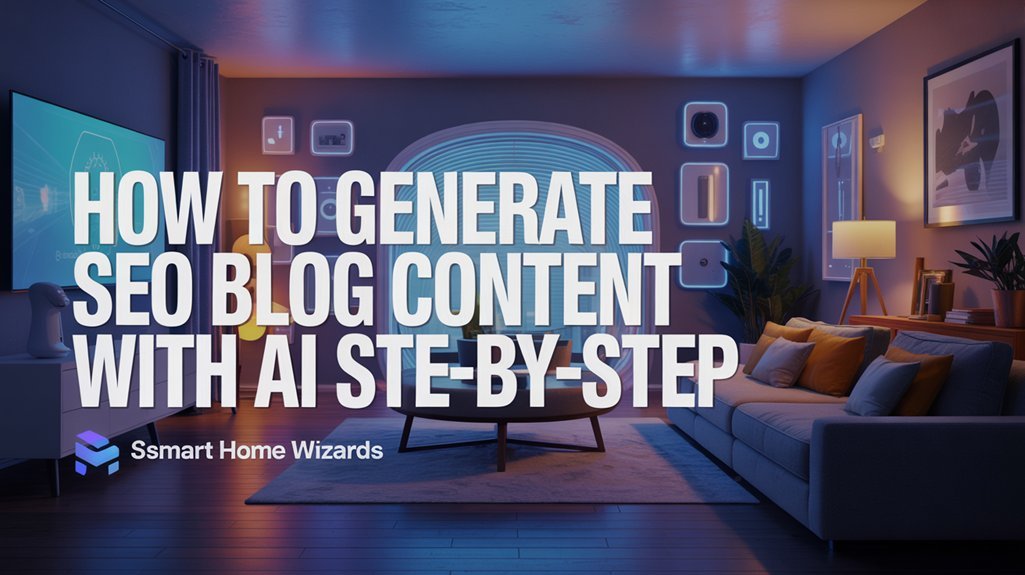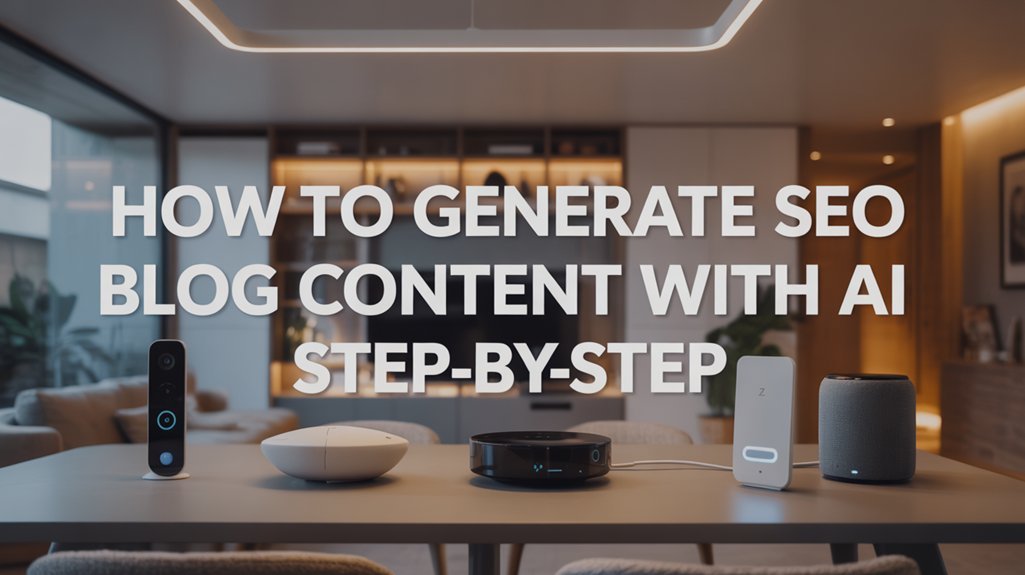
You'll generate SEO blog content with AI by first defining measurable goals and identifying high-value keywords with 10-100 monthly searches to minimize competition. Next, you'll analyze the top 10 competitor results to extract heading structures and content gaps. Then you'll use AI tools to create structured drafts with strategic keyword placement in H2s and H3s. Finally, you'll humanize the content by infusing your brand voice, adding personal anecdotes, and implementing internal links while monitoring performance metrics weekly. The sections below break down each tactical step.
Key Takeaways
- Define clear SEO goals and identify high-value keywords with strong purchase intent using tools like Google Keyword Planner or SEMrush.
- Analyze top-ranking competitor content to extract heading structures, content patterns, and identify gaps for strategic ranking opportunities.
- Use AI tools to generate SEO-optimized content frameworks with detailed prompts specifying target keywords, brand voice, and audience tone.
- Humanize AI-generated content by adding personal anecdotes, brand voice, and using readability tools to enhance skimmability and engagement.
- Implement strategic internal linking during content creation and monitor performance metrics weekly to refine and optimize existing content.
Define Your SEO Goals and Target Audience
Why do some AI-generated blog posts rank on page one while others languish in obscurity? The answer lies in defining precise SEO goals before you write a single word. Start by establishing measurable objectives—whether that's 40% organic traffic growth or specific keyword rankings within 90 days.
Next, dissect your target audience through customer surveys and analytics data. You'll uncover their pain points, search patterns, and content preferences that drive audience behavior. This intelligence alters generic AI output into strategic assets.
Your keyword research must balance search volume with conversion potential. Don't chase vanity metrics—focus on terms that attract decision-makers who'll take action.
Align these elements into a cohesive content strategy that directs your AI tool's output. Without this foundation, you're fundamentally asking AI to guess what ranks. With it, you're commanding precise results that dominate search rankings and drive measurable business outcomes. Consider implementing an AI SEO content optimizer to streamline this process and ensure your content strategy remains data-driven and results-focused.
Research and Select High-Value Keywords
You'll need to prioritize bottom-funnel keywords that signal purchase intent, as these terms convert at rates 2-3x higher than top-funnel awareness keywords.
Start by filtering your keyword list for monthly search volumes between 10-100, which typically indicates lower competition while maintaining sufficient traffic potential.
This strategic approach targets users who've already moved past the research phase and are actively seeking solutions, maximizing your content's ROI.
Once you've identified your target keywords, implement AI content optimization techniques to ensure your blog posts are structured in ways that search engines can easily crawl and rank.
Identify Bottom-Funnel Keywords
When you're ready to capture buyers at the decision stage, bottom-funnel keywords become your most valuable targeting opportunity.
Target phrases containing “buy,” “discount,” or “best price” that signal immediate purchase intent and drive superior SEO performance.
Deploy keyword research tools like Google Keyword Planner and SEMrush to identify bottom-funnel keywords with monthly search volume between 10-100.
This range delivers ideal conversion-focused content opportunities with manageable competition levels.
Execute competitor content analysis to understand what ranks and converts.
Study their successful posts to identify content marketing patterns that resonate with buyers.
Strategically position these bottom-funnel keywords throughout your content—in headings, opening paragraphs, and naturally within body text.
This precise incorporating keywords approach aligns with user intent, enhances visibility, and changes content into revenue-generating assets.
Leverage AI SEO simulation to test how different keyword placements and content variations perform before publishing, allowing you to optimize for maximum search visibility and conversion potential.
Analyze Monthly Search Volume
Monthly search volume data converts keyword selection from guesswork into strategic decision-making that directly impacts your content's traffic potential.
You'll access Google Keyword Planner to extract precise monthly search volume metrics, targeting keywords with 10-100 searches for ideal conversion rates while minimizing competition. High-value keywords emerge when you balance search volume against audience needs and content relevance.
Track keyword trends to identify emerging opportunities before competitors saturate the space. Your content strategy gains power through systematic analysis—document selected keywords in a keyword tracker to monitor performance fluctuations and inform content production priorities.
Focus on keywords demonstrating consistent growth patterns rather than temporary spikes. AI insights can further optimize your content strategy by revealing patterns in keyword performance and audience behavior that manual analysis might miss. This data-driven approach positions your SEO blog content to capture traffic systematically, altering raw search data into actionable intelligence that drives measurable results.
Analyze Top-Ranking Competitor Content
You'll need to systematically examine the top 10 search results for your target keywords to extract actionable intelligence from their performance.
Start by documenting each competitor's URL, content length, and heading hierarchy to identify patterns that signal ranking success.
This structural analysis reveals the specific SEO elements—keyword placement, internal links, and content depth—that you'll replicate and improve in your AI-generated content.
Identify Top Ranking URLs
Before you create content that ranks, you need to understand what's already winning in the search results. Input your target keywords into Google and compile the top 5–10 URLs. Use SEO tools like Ahrefs or SEMrush to identify top ranking URLs and assess their domain authority, revealing your competitive landscape.
| Analysis Focus | Strategic Action |
|---|---|
| Content Structure | Evaluate headings, length, format |
| Keyword Targeting | Extract long-tail keywords and variations |
| Domain Authority | Measure competitive positioning |
| User Engagement | Review comments for common questions |
Analyze content patterns across these competitors. Examine which keywords they're ranking for and identify gaps in their content strategy. Study user engagement metrics—social shares, backlinks, and comment sections reveal pain points you can dominate. This data-driven approach converts competitor intelligence into your ranking advantage.
Evaluate Content Structure Patterns
Top-ranking content follows predictable structural patterns that you can decode and replicate. When analyzing top-ranking competitors, extract their heading hierarchies using the Detailed SEO Chrome Extension to identify winning frameworks.
Document critical SEO performance indicators: content length, keyword usage density, and organizational architecture. Track engagement metrics—comments, shares, and backlinks—to pinpoint which content structures drive results.
Deploy the Skyscraper Method strategically: build superior AI-generated content that surpasses competitor depth and quality. Map their structural elements while engineering improvements that enhance for better search visibility.
Your content strategy must reshape competitor insights into actionable dominance. Examine how top performers integrate keywords naturally throughout their hierarchy.
This data-driven approach positions your AI-generated content to outrank established competitors by systematically eliminating their structural advantages and amplifying proven content structure patterns.
Extract Key SEO Elements
When competitors dominate page one, their content reveals exploitable SEO patterns you can systematically extract and weaponize.
Deploy AI-powered tools to dissect their keyword research strategies, identifying primary terms and semantic variations that drive rankings. Analyze engagement metrics—comments, shares, backlinks—to determine what content creation approaches command authority.
Extract these critical SEO elements:
- Keyword density patterns and strategic placement within titles, headers, and body text
- Internal linking architecture connecting related blog posts for maximum crawl efficiency
- Content depth requirements (typically 1,500+ words for competitive queries)
- Structural frameworks including H2/H3 hierarchies that search algorithms reward
Apply the Skyscraper Method: identify their outdated pieces, then engineer superior high-quality content with current data, improved visuals, and thorough coverage that obliterates their market position.
Extract Effective Heading Structures and Content Gaps
Competitor analysis reveals the blueprint for content that dominates search rankings.
You'll extract effective heading structures from five high-ranking posts using tools like the Detailed SEO Chrome Extension, enabling systematic evaluation of their content organization. This data-driven approach exposes what works and what doesn't in your niche.
Your next move: identify content gaps that competitors overlooked.
Examine their keyword targets and heading hierarchies to discover unanswered questions and missing information that diminishes user experience. These gaps represent your competitive advantage.
Competitor content gaps are your strategic advantage—unanswered questions that diminish their user experience become your ranking opportunities.
Deploy the Skyscraper Method strategically.
You're not just copying competitor structures—you're building superior content that fills identified gaps while maintaining ideal blog relevance. Each heading should target specific keywords while enhancing SEO performance through logical content flow.
Update your Content Map continuously with newly discovered heading structures and keyword opportunities.
This systematic competitor analysis guarantees your content doesn't just compete—it dominates search rankings through strategic superiority.
Generate AI-Powered Blog Outlines and First Drafts
AI-powered outline generation converts your keyword research and competitor insights into structured, SEO-optimized content frameworks within minutes.
You'll utilize an AI tool to generate content that accelerates your workflow while maintaining strategic precision.
Your SEO strategy demands systematic execution. When you create your blog outline and first draft, follow this protocol:
- Input thorough prompts specifying target keywords, brand voice parameters, and content ideas extracted from competitor analysis
- Define keyword placements within H2s and H3s to enhance search visibility while maintaining natural flow
- Generate the first draft using detailed instructions about tone, audience sophistication level, and desired content depth
- Refine the output by injecting proprietary insights and adjusting language to match your brand's authority positioning
This approach converts raw data into high-quality content that ranks.
You're not replacing human expertise—you're amplifying your strategic advantage through intelligent automation that scales your content production without sacrificing optimization standards.
Humanize and Edit AI-Generated Content
Raw AI output represents your foundation, not your finished product. Human intervention alters generic text into strategic content that drives results.
Start by conducting a thorough review and edit, verifying every statistic and fact for accuracy. Your brand voice distinguishes you from competitors—infuse it deliberately into each paragraph.
Strategic humanization demands authentic storytelling. Inject personal anecdotes that create relatable content your audience craves. These insights build authority and trust that pure AI can't replicate.
Deploy readability tools to enhance text structure. Your audience demands skimmable, power-packed paragraphs that deliver immediate value.
Don't operate in isolation. Systematically collect feedback from team members and target users to align with audience expectations. This data informs your refinement process, ensuring each iteration strengthens performance metrics.
Alter AI drafts into conversion assets through deliberate, strategic editing that positions your brand as the definitive authority.
Optimize Internal Linking Strategy
While AI generates your foundation, internal linking converts isolated posts into a cohesive authority network that dominates search rankings. Your SEO content needs strategic connections that improve SEO performance and drive user engagement by 50% through deliberate link placement.
Execute this internal linking framework to boost visibility in search results:
- Connect high-authority pages to underperforming content – Channel existing ranking power to lesser-known related articles.
- Embed contextual anchor text naturally – Use keyword-focused phrases that signal relevance to search algorithms.
- Link during content creation – AI-generated posts offer prime opportunities for immediate strategic connections.
- Update internal links quarterly – Refresh outdated connections to maintain Google's favor and recover lost traffic.
Analyze your existing content hierarchy to identify linking opportunities. Each connection strengthens your site structure while improving crawlability.
Focus on relevance over quantity—three strategic links outperform ten random connections. Your internal linking strategy alters individual posts into an interconnected power system.
Monitor Performance and Refine Your Approach
Your AI-generated content isn't finished once it's published—performance monitoring converts average posts into traffic-generating assets. Track key performance indicators including organic traffic, bounce rates, and conversion rates through Google Analytics and SEMrush to measure content effectiveness.
These tools reveal precise user engagement patterns and identify which topics dominate your niche.
Implement A/B testing on headlines and content formats to elevate click-through rates. Data-driven decisions eliminate guesswork from your content strategy.
Gather feedback from readers through comments and surveys—direct intelligence shapes your competitive advantage. Use these insights to refine your approach systematically.
Monitor performance metrics weekly, then improve existing blog posts based on results. Update underperforming content with current SEO trends, stronger keywords, and upgraded formatting.
This continuous refinement cycle changes initial posts into ranking powerhouses. Your authority grows as you adapt, ensuring your AI-generated content maintains market dominance while competitors stagnate with static strategies.
Frequently Asked Questions
Can I Use Ai-Generated Content for SEO?
You can absolutely utilize AI content for SEO effectiveness when you strategically enhance it.
Your content strategy must prioritize content originality and address plagiarism concerns through human editing. Focus on keyword enhancement while ensuring audience engagement remains authentic.
You'll elevate search rankings by combining AI efficiency with ethical considerations—never publish raw AI output.
This data-driven approach positions you to dominate organic traffic, but your competitive edge depends on refining AI-generated material to match search intent and establish authority.
Can You Use AI to Generate Blog Posts?
Yes, you'll utilize AI blogging to dominate content creation with superior writing efficiency.
You'll generate strategically enhanced posts while maintaining content quality through rigorous keyword integration and topic relevance.
You'll command audience engagement by combining AI-generated drafts with powerful editing tools that guarantee content originality.
You'll amplify your competitive advantage by addressing ethical considerations upfront, converting raw AI output into authoritative content that ranks.
You'll control the entire process while scaling your content empire exponentially.
Which AI Tool Is Best for SEO Content Generation?
Jasper.ai dominates as your premier AI writing software for SEO content generation, delivering superior keyword integration strategies and content quality assessment features.
You'll utilize SurferSEO's real-time optimization techniques to outrank competitors, while NeuronWriter's built-in editor guarantees content originality checks.
These AI content tools boost your content creation efficiency by 300%, though you must balance user engagement metrics carefully—AI versus human writers debates prove strategic oversight remains essential for maintaining authentic power in your content marketing dominance.
How to Write SEO Friendly Content Using AI?
You'll master SEO-friendly content by deploying AI writing techniques that prioritize keyword enhancement methods and content relevance importance.
Start with strategic AI content tools to analyze user engagement metrics and readability factors. Implement SEO content strategies that target voice search improvement while maintaining content freshness relevance.
You're positioning yourself to dominate search rankings by leveraging data-driven insights that align with search intent.
Execute systematically—research keywords, generate AI-powered outlines, enhance naturally, then refine with human expertise to crush your competition's content performance.
Conclusion
You've revealed the blueprint—now execute like a Swiss watchmaker. Your keyword research, competitor analysis, and AI-generated drafts mean nothing without strategic implementation. Track your rankings weekly, refine content based on search console data, and double down on what converts. Rome wasn't built in a day, but your SEO momentum compounds with every enhanced post. Deploy these steps systematically, measure obsessively, and watch your organic traffic climb. The algorithm rewards consistency and precision—deliver both.

